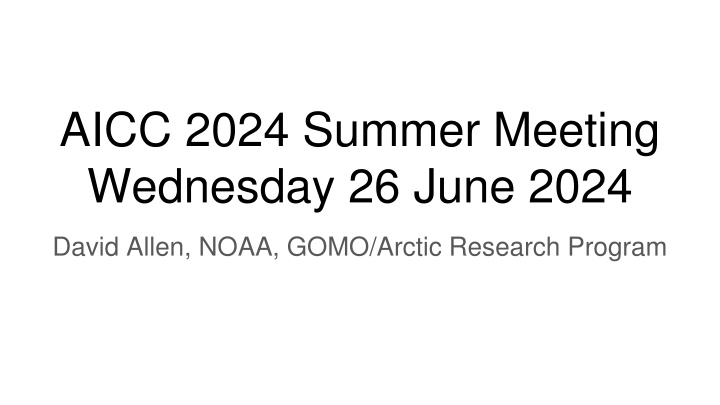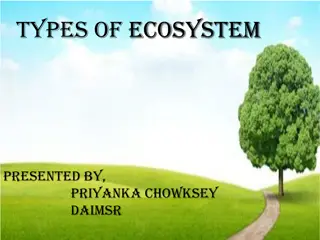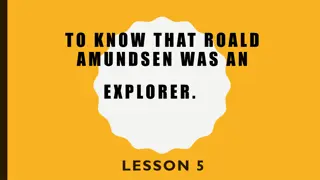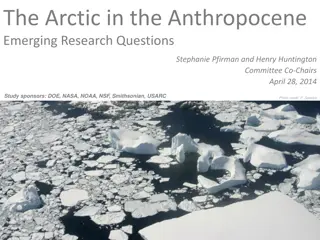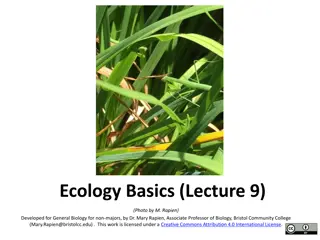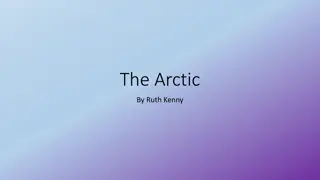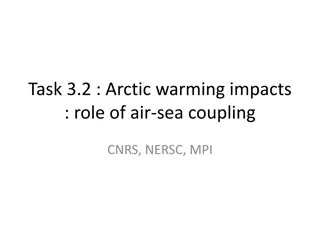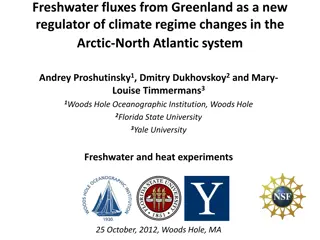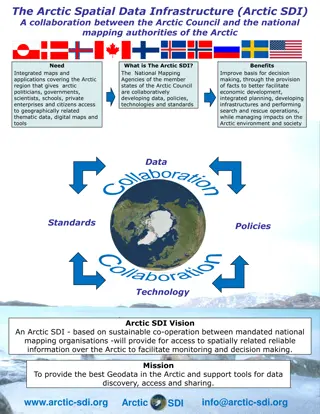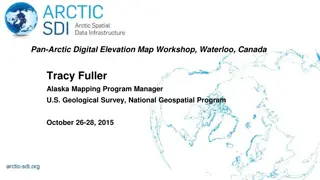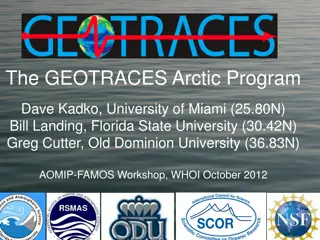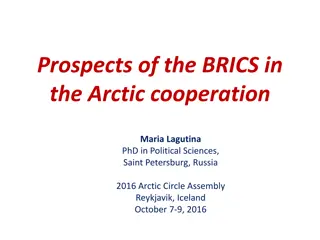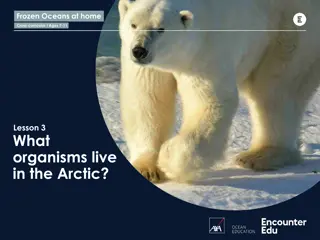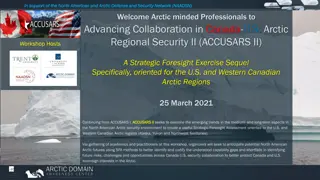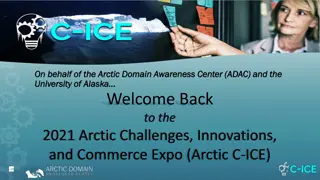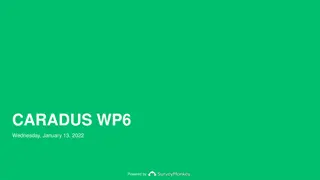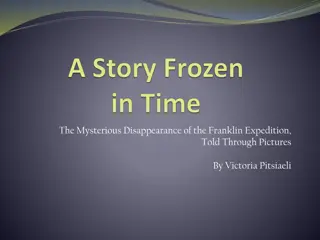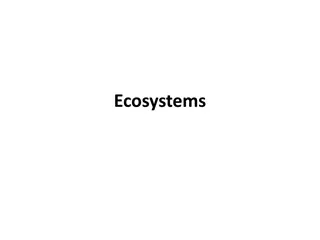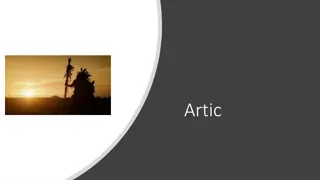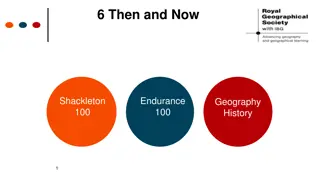Arctic Research Expedition 2024: Mission to Explore Pacific Arctic Ecosystems
Researchers are embarking on a crucial expedition in August 2024 to study the environmental changes in the Pacific Arctic. Led by scientists from NOAA and UAF, the team aims to assess biodiversity, ecosystem status, and ongoing changes in the northern Bering and Chukchi Seas. The expedition will involve various data collection activities such as seabird surveys, water column sampling, seafloor analyses, and deployment of moorings. The mission is driven by the need to understand the factors influencing marine animal populations and ecosystem dynamics in the region.
Download Presentation

Please find below an Image/Link to download the presentation.
The content on the website is provided AS IS for your information and personal use only. It may not be sold, licensed, or shared on other websites without obtaining consent from the author.If you encounter any issues during the download, it is possible that the publisher has removed the file from their server.
You are allowed to download the files provided on this website for personal or commercial use, subject to the condition that they are used lawfully. All files are the property of their respective owners.
The content on the website is provided AS IS for your information and personal use only. It may not be sold, licensed, or shared on other websites without obtaining consent from the author.
E N D
Presentation Transcript
AICC 2024 Summer Meeting Wednesday 26 June 2024 David Allen, NOAA, GOMO/Arctic Research Program
SKQ2024-12S: DBO/EcoFOCI-AMBON-CEO Collaborative Ecosystem Cruise Jackie Grebmeier1,Seth Danielson2*, Matt Galaska3**, Katrin Iken2 & Phyllis Stabeno3 1University of Maryland Center for Environmental Science, 2University of Alaska Fairbanks *=Chief Scientist, **=Co-Chief scientist jgrebmeier@umces.edu, sldanielson@uaf.edu DBO: Distributed Biological Observatory (Jackie Grebmeier, UMCES) EcoFOCI: Ecosystems and Fisheries Oceanography Coordinated Investigations (Phyllis Stabeno/NOAA) AMBON: Arctic Marine Biodiversity Observation Network (Katrin Iken, UAF) CEO: Chukchi Ecosystem Observatory (Seth Danielson, UAF) Contact: Seth Danielson, sdanielson@uaf.edu, Jackie Grebmeier, jgrebmei@umces.edu
Research Expedition Details Dates: August 6-27, 2024 Research Area Location: Northern Bering and Chukchi Seas Vessel: R/V Sikuliaq (mob July 29 Seward, embark August 5, demob Aug 28, Nome) Funding: Financial support provided by NOAA, ONR, AOOS, NASA, NPRB, NSF, USFWS, UAF Communication and outreach plans: o Pre & post-cruise discussions & reporting-back with AEWC o Daily communication of activities with Alaskan coastal communities o In Nome: Planned Strait Science talk, visit local school classrooms, student tour of R/V Sikuliaq Contact: Seth Danielson, sdanielson@uaf.edu, Jackie Grebmeier, jgrebmei@umces.edu
Key Scientific Questions & Motivations Mission: To track the status and change in environmental drivers and ecosystem components undergoing change in the Pacific Arctic Goals: Evaluate ecosystem status, biodiversity, and change at DBO, AMBON and EcoFOCI time series stations Deploy and recover NOAA and UAF moorings Identify ongoing ecosystem changes in the northern Bering and Chukchi Seas Determine conditions that cause marine animal populations to vary Brief summary of activities: Underway Observations: Seabird and marine mammal surveys from bridge Water Column: CTD sampling for water temperature, salinity, bio-optical parameters, eDNA, harmful algal bloom monitoring, water samples for nutrients, water composition, Bongo net tows for zooplankton and larval fish Seafloor: Animals in the sediment and on the bottom via grabs and trawls, sediment grain size and chlorophyll a, harmful algal bloom sampling, organic carbon and nitrogen, oxygen consumption via benthic HAPs core Moorings: Biophysical and passive acoustic Contact: Seth Danielson, sdanielson@uaf.edu, Jackie Grebmeier, jgrebmei@umces.edu
EcoFOCI Fall Mooring Cruise Research Expedition Details Dates: 9/7 - 9/25, 2024 Research Area Location: SE Bering Sea/ US Arctic Vessel: NOAA Ship Oscar Dyson Communication and outreach plans: Yes. Please contact: Primary: heather.tabisola@noaa.gov; w/ CC: theo.stein@noaa.gov, and marjorie.mooney- seus@noaa.gov Social Media: @NOAAResearch, @NOAAFisheriesAK (IG) Map showing the overall working area and operational sampling plan for cruise DY24-10. Contact Information: phyllis.stabeno@noaa.gov, heather.tabisola@noaa.gov
Key Scientific Questions & Motivations Mission: Annual survey to provide baseline fisheries and oceanographic data to support sustainable management of living resources in the Bering Sea and the rapidly changing US Arctic ecosystem. Goals: Goals of the spring mooring cruise include a turn around of various NOAA biophysical (PMEL) and passive acoustic (AFSC) moorings located in the Bering Sea, perform CTD (PMEL), Bongo and CalVET (AFSC) surveys at long-term EcoFOCI sampling sites. Brief summary of activities: (Spring) This project is intended to recover five (5) PMEL subsurface moorings and to deploy five (5) PMEL subsurface moorings and two (2) PMEL surface moorings at the Bering Sea sites of M2, M4, and KU2. In addition, four (4) marine mammal moorings (AFSC) are to be recovered and four (4) marine mammal moorings will be deployed. A hydrographic/biological survey consisting of Conductivity/Temperature/Depth (CTD) casts, 20/60 cm bongo tows and California Vertical Egg Tows (CalVETs) in the Unimak Pass area, along the 70-meter isobath in the Bering Sea as far north as the sea ice permits, and in boxes around the 4 mooring sites at M2, M4, M5, & M8. Additionally, we will deploy one (1) satellite tracked drifter. No gliders, sonobuoys, or pop-ups will be deployed this cruise. Additional projects include HABs, Flow Cytometry, eDNA and an IFCB. Fall is similar and in current planning process. Contact Information: phyllis.stabeno@noaa.gov, heather.tabisola@noaa.gov
NOAA Icebreaker Requirements Working Group The ExComm appointed David Allen (OAR/GOMO Arctic Research Program) and John (Jay) Lomnicky (OMAO/NOAA Corp Liaison to USCG) as co-leads of this working group. The working group should regularly update the AAT and the ExComm of its progress The working group includes representatives from all line offices By Sept 30, 2024 (~6 months), the working group will produce a short white paper or report to the ExComm on NOAA icebreaker requirements, plus a living document of requirements (e.g., google doc) underpinning the report that can be routinely updated for taskers and queries. The report and living document will be used for internal and external NOAA work, the UNOLS Arctic Icebreaker Coordinating Committee (AICC) and Congress on NOAA-USCG icebreaker needs and requirements. This working group will be available for responding to requests and/or future actions for icebreaker requests.
